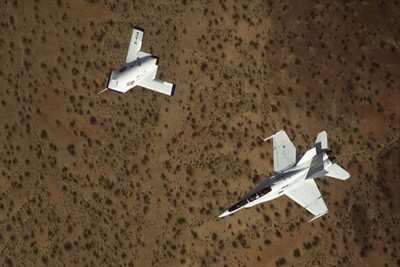Tue, Dec 28, 2004
A Boeing X-45A unmanned aircraft was controlled by a
pilot-operator in Seattle, Wash., after launching from NASA's
Dryden Flight Research Center, Edwards Air Force Base, Calif., on
early December.

“This shows our military can deploy unmanned combat
aircraft from one location and control them from another,”
said Darryl Davis, Boeing Joint Unmanned Combat Air Systems
(J-UCAS) X-45 vice president and program manager. “We're
moving quickly toward delivering a 24/7 strike and reconnaissance
capability to complement America 's manned fighter and bomber
force.”
Using ‘line of sight' command and control, the technology
demonstrator aircraft departed in the morning with a pilot-operator
controlling the jet from its home in Southern California. Once
airborne, the pilot-operator handed control of the unmanned vehicle
over to another Boeing pilot in Seattle. Taking command of the
X-45A using a UHF satellite communications (SATCOM) link, the
Seattle-based pilot-operator demonstrated
‘beyond-line-of-sight' control by commanding multiple
altitude and airspeed changes, which were executed by the vehicle.
Operating from a systems integration lab nearly 900 miles away, the
pilot-operator managed the jet for approximately six minutes before
turning command back to the California-based team, which returned
it to Edwards AFB safely after nearly an hour in the air.

The test mission demonstrated safe and secure vehicle handoff
from mission control to another control center through a SATCOM
link. That capability will be critical when operating the X-45C, a
more robust version of the aircraft being built in St. Louis.
Boeing was recently awarded $767 million in funding from the
Defense Advanced Research Projects Agency (DARPA) to build and
demonstrate three X-45C aircraft, two mission control elements, and
to integrate a common operating system technology for the J-UCAS
program. The first X-45C flight is scheduled to take place in early
2007.

The J-UCAS X-45 program is a DARPA/US Air Force/US Navy/Boeing
effort to demonstrate the technical feasibility, military utility
and operational value of an unmanned air combat system for the Air
Force and the Navy. Operational missions for the services may
include suppression of enemy air defenses; strike; electronic
attack; intelligence, surveillance and reconnaissance; and
persistent global attack. The two X-45A technology demonstrators
are currently verifying the core functionality of the software
necessary for these and related missions.
More News
Aero Linx: Model Aeronautical Association of Australia MAAA clubs are about fun flying, camaraderie and community. For over 75 years, the MAAA has been Australia’s largest fl>[...]
Touchdown Zone Lighting Two rows of transverse light bars located symmetrically about the runway centerline normally at 100 foot intervals. The basic system extends 3,000 feet alon>[...]
“Discovery and innovation are central to our mission at Virgin Galactic. We’re excited to build on our successful record of facilitating scientific experiments in subor>[...]
How To Get A Story On Aero-TV News/Feature Programming How do I submit a story idea or lead to Aero-TV? If you would like to submit a story idea or lead, please contact Jim Campbel>[...]
Student Pilot Reported That During Rotation, “All Of A Sudden The Back Of The Plane Kicked To The Right..." Analysis: The student pilot reported that during rotation, “>[...]
 ANN's Daily Aero-Linx (05.02.24)
ANN's Daily Aero-Linx (05.02.24) ANN's Daily Aero-Term (05.02.24): Touchdown Zone Lighting
ANN's Daily Aero-Term (05.02.24): Touchdown Zone Lighting Aero-News: Quote of the Day (05.02.24)
Aero-News: Quote of the Day (05.02.24) ANN FAQ: Contributing To Aero-TV
ANN FAQ: Contributing To Aero-TV NTSB Final Report: Cirrus Design Corp SR20
NTSB Final Report: Cirrus Design Corp SR20





